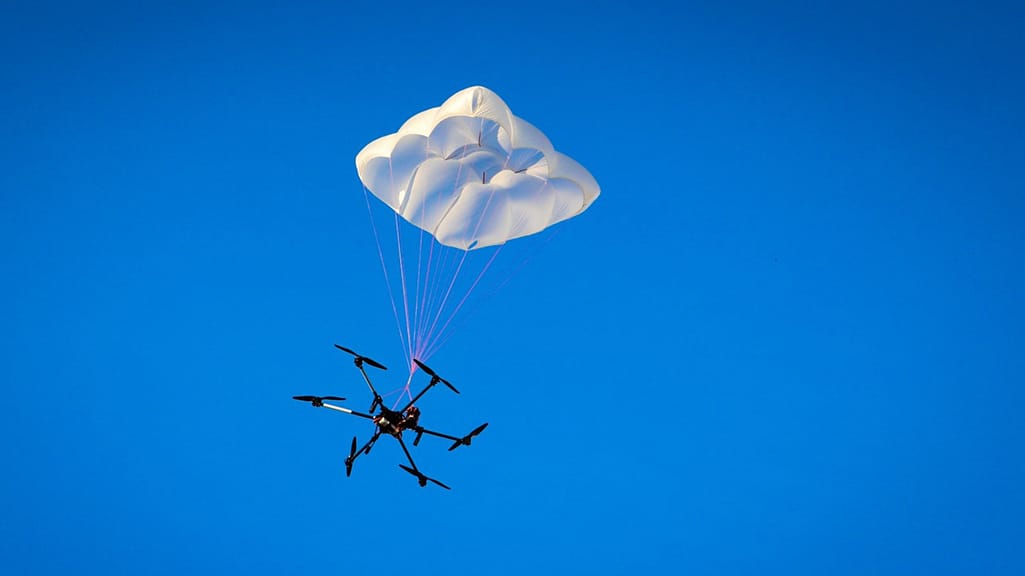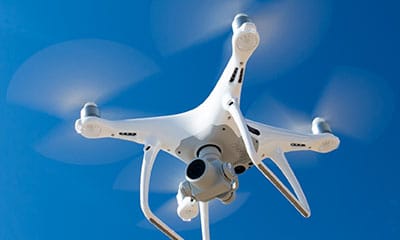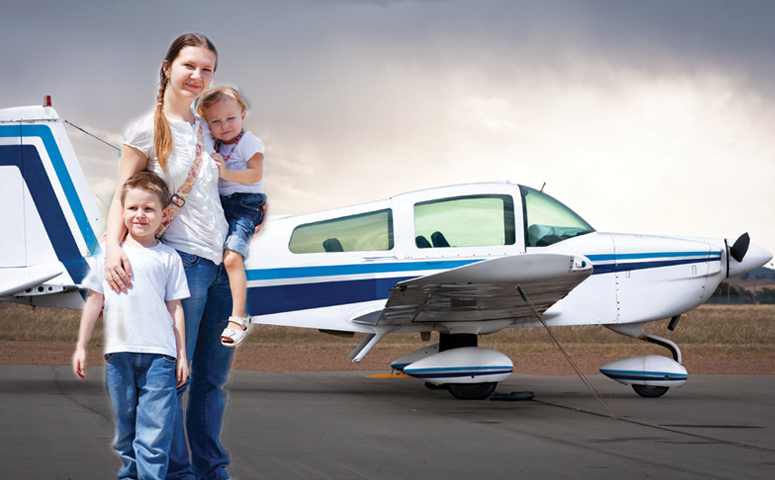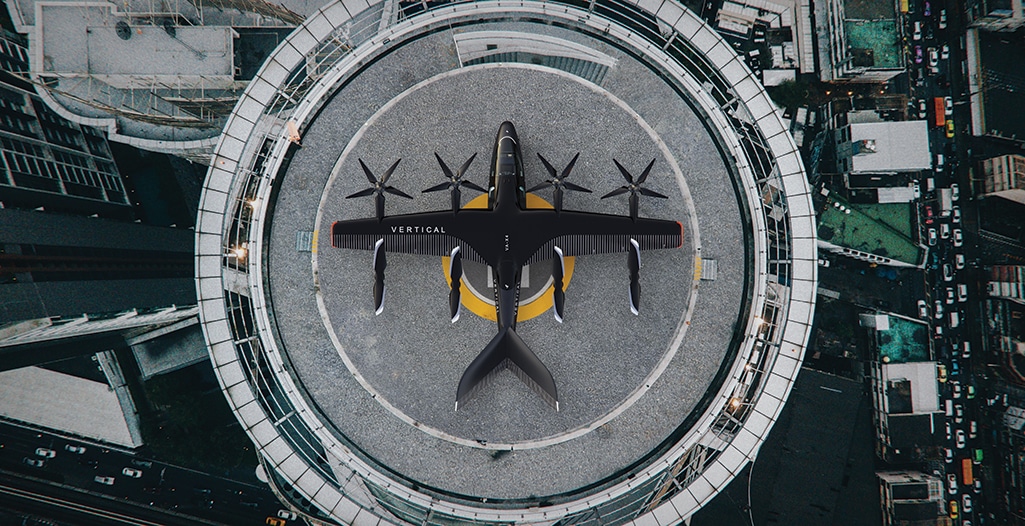Drone Parachutes: A Reasonable Safety Feature?
Author: Alex Seidenberger, Drone Rescue Systems
One of the central questions aviation regulators around the globe are currently working on is how widespread drone operations can be integrated into airspace in a way that protects people and property from malfunctions. Much like in manned aviation, a regulatory framework will have to be established for unmanned operations to ensure flight safety—especially when considering the scaling potential of this industry with flights beyond the sight of the operator.
Parachutes stand to gain more significance in this new legal environment and are making their way from a niche product to a critical safety feature.

How Do Drone Parachutes Work?
A parachute reduces the impact energy on the ground when a drone crashes. Its purpose is to prevent harm to people or objects on the ground and to protect the drone from being destroyed. If all other safety measures fail, a parachute acts as the last line of defense by bringing down a defective drone safely.
Comparing the impact energy of a 10-kilogram drone falling from 50 meters reveals how effective these systems can be in preventing serious incidents. It experiences approximately 4,900 joules in free fall compared to approximately 80 joules with, for example, a DRS‐10 parachute from Drone Rescue Systems. This, however, requires parachutes to be activated reliably and deployed quickly, which is accomplished in very different ways by the current systems available on the market.
How Are Drone Parachutes Activated?
Activation can happen manually with a remote trigger or automatically through onboard failure detection. While manual activation seems very reliable, it depends on the pilot’s judgment and reaction time. Consequently, it usually is not effective at saving a drone operating at low altitude.
Automatic activation, on the other hand, detects “unnatural” behavior of the drone by monitoring various parameters like descent rate, pitch or roll angles. If a predefined value, or set of values, is exceeded, the parachute is deployed. This happens very quickly—usually before the drone can be seen tumbling or falling by the pilot, which has led to confusion among early users who believed their activations were false alarms.
How Are Drone Parachutes Deployed?
There are four main deployment methods:
Spring release deployment: This method uses loaded springs to eject the parachute. It is a very common method that benefits from being lightweight and inexpensive, but with a high rate of successful deployment. However, re‐installing the parachute after ejection can be tricky since the springs are heavily compressed.
Sling/catapult release deployment: This method uses elastic bands to eject the parachute. It does not require any metal components and, therefore, has the lowest weight by far and is very easy to handle and re‐install.
Pyrotechnic deployment: This system uses explosives to eject the parachute. It is a medium-weight solution but has powerful ejection. However, the reaction force can damage the drone. Some countries require special licenses/certificates to handle explosives, and classification of these systems as “dangerous goods” might limit travel (especially air travel) and shipment.
Compressed‐gas deployment: This method is similar to the pyrotechnic deployment but uses compressed gas like CO2 instead of explosives. It produces fast and efficient ejection but requires comparatively heavy components.
When Do I Need a Drone Parachute?
From a legal perspective, whenever applying for an exception to fly restricted operations, like beyond visual line-of-sight or directly over people. In many countries, these operations require approval by aviation authorities, and installing a parachute can be essential for meeting the requirements to obtain such approval.
For example, statistics from the FAA show that in the first half of 2021, over 90% of waiver applicants used a parachute system for ground risk mitigation. All of them were certified according to the ASTM F3322‐18 standard—a testing procedure overseen and documented by aviation authorities for proving the system’s performance.
From a safety perspective, you should use a drone parachute whenever there is heightened risk of people on the ground getting hit by a falling drone. Even a medium-sized drone can cause fatal injuries to a person or create severe consequences as a result of impact with critical infrastructure. With drone businesses scaling up, incidents like these are likely to increase in frequency. Using parachutes is a good way to minimize the damage from them.
From a cost perspective, it is a good idea to use a drone parachute whenever a drone carries expensive equipment. Commercially used drones often carry sensors or cameras that can cost up to hundreds of thousands of dollars and are essential for businesses to run their operations. A parachute can save the equipment and acts as “insurance” that helps these companies stay in business—even enabling them to continue their mission right away, in many cases. Furthermore, as the safety case is made, insurance companies are increasingly likely to offer incentives to their customers, like lower premiums or deductibles, when a parachute is used.
Are There Downsides to Drone Parachutes? What Should I Look Out For?
Parachutes must be installed on the drone and, thus, they add weight. This means reduced flight time and a reduced capacity for further payloads. Low system weight is, therefore, one of the most desirable features of a parachute solution.
The parachute may also occupy space needed for other payloads, like on top of the drone. To reduce these negative influences, it makes sense to compare systems as they greatly differ in their positioning and total weight.
Reliability is a quality every parachute system should have, even though this is hard to assess for pilots. Early versions had some issues with reliably detecting emergency situations and could even cause accidents. However, much has happened in the industry since to make the systems more reliable.
Advanced parachute systems today store flight data in a black box in order to determine what caused the activation. They can then leverage that data to optimize activation parameters. Therefore, you should make sure the parachute is designed for your type of drone specifically. If there is no off‐the‐shelf solution available, some companies customize their products. Do not try to integrate generic solutions on your own.
Many unsuccessful deployments are caused by parachute lines becoming entangled in the rotors of the drone. For that reason, it is worth establishing if the parachute system has integrated flight termination that automatically stops the rotors when the parachute is ejected.
Lastly, further instruction on how to fit the parachute system and prevent accidental deployment should be undertaken. This should include creating awareness of the limitations of these systems to prevent operators from flying in unsafe situations and becoming over‐reliant on the parachute’s ability to prevent a potential catastrophe.
Should I Buy a Drone Parachute Now?
Parachutes can make drone operations much safer, but there is an upfront financial investment. While they are an optional safety feature for low‐risk flight operations, they can be essential in more-challenging environments.
As operators try to make drone services more common, they are pushing the boundaries to fly further out of sight and over more-populated areas. If planning to apply for a waiver for this type of mission, one should assess the benefits of installing a parachute, as regulators around the world will likely require a parachute as a condition of providing approvals for such operations.
Avoiding crashes and expensive repairs can also reduce the overall costs of operating a drone and make a parachute a reasonable investment. When looking to make a purchase, keep in mind that a good system should be light, automatic, and reliable, with integrated flight termination. This type of system can be purchased at many drone stores as well as directly from most manufacturer websites.
Resources
Drone Parachute Report 2021 (DRONII)




